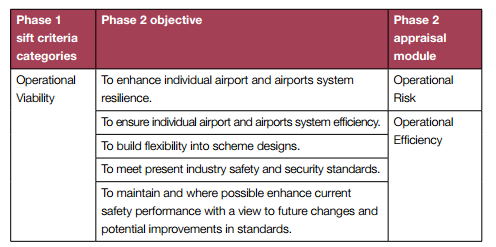Airports Commission publishes final version of its Appraisal Framework for short-listed runway schemes
The Airports Commission has published its final Appraisal Framework which is the document it will use to assess the 3 short-listed options for one net new additional runway. There was a consultation draft of the appraisal framework, in January. The Appraisal Framework sets out how the Commission expects the runway scheme designs to be developed, and how the schemes will be appraised by the Commission. The deadline for scheme submissions is now 14th May (not 9th). The Appraisal Framework has a list of “sift criteria categories” which are: strategic fit, economy, surface access, environment, people, cost, operational viability, and delivery. Within these categories are a list of “appraisal modules” with things like “noise, air quality, biodiversity, carbon, water and flood risk, and place” under environment. The Commission hopes “The objectives conform to the principles of mitigating and adapting to climate change and achieving good design, and they should ensure that schemes balance national, local and commercial interests.” It adds that ” it is unlikely that proposals will meet each objective to an equal degree and that an element of ‘trade off’ between objectives might therefore be required.”
.
Tweet
List of objectives – below
Airports Commission appraisal framework
Published: 2 April 2014 PDF, 1.25MB, 136 pages
Appraisal framework consultation responses summary
Published: 2 April 2014PDF, 118KB, 9 pages .https://www.gov.uk/government/consultations/airports-commission-appraisal-framework
.
Airports Commission: Appraisal Framework Consultation Responses Summary Document
The Airports Commission published its Draft Appraisal Framework for consultation on 16 January 2014, to which the Commission received over 70 responses. The Appraisal Framework document published alongside this one sets out a revised framework amended in the light of the comments received. This paper summarises some of the main themes contained in those responses.
.
Airports Commission: Appraisal Framework
The Commission’s proposed approach is based on the same sift criteria categories used in assessing long-term options in the first phase of its work. These categories are:
3.4 Table 3.1 sets out the Commission’s proposed objectives, and displays how each objective corresponds to an appraisal module located in Appendix A. Further explanation of each objective is provided in the corresponding module.”
,
Below are some quotes on the general content of the Appraisal Framework
The Commission should base the recommendations in its final report on a detailed consideration of the case for each of the credible options. This should include the development or examination of detailed business cases and environmental assessments for each option, as well as consideration of their operational, commercial and technical viability.
To understand better the economic, social and environmental impact of the short-listed options, as well as their operational and commercial viability, the Commission will now subject them to a more detailed, wider-ranging and comprehensive analysis than occurred in Phase 1.
The results of this analysis will be put to national consultation in autumn of this year and, ultimately, will be published alongside the recommendations in the Commission’s final report to the Government.
The Commission’s intention is that, as well as informing its recommendations, these outputs can be used by the Government as a strong evidential base to support the delivery of its final recommendation, should Government choose to take this forward, for example as materials in the preparation of a National Policy Statement or Hybrid Bill, and/or to accelerate the resolution of any future planning application(s) by scheme promoters. Any decisions about national policy will ultimately be for the Government.
.
This Appraisal Framework sets out in detail how the Commission expects scheme designs to be developed, and how the schemes will be appraised. The framework incorporates four inter-related elements, each of which is described in more detail in this document:
• the Commission’s objectives, against which options will be assessed and on which its final recommendations will be based;
• an updated scheme design for each short-listed option, to be used as the starting point for appraisal;
• a business case and sustainability assessment for each option, incorporating the information needed to make informed assessments against the Commission’s objectives; and
• a set of appraisal modules explaining the methodologies that the Commission proposes to use in assessing options
. …. This revised and updated version of the Appraisal Framework constitutes the final version that the Commission will publish and as such replaces the earlier draft version (for this reason, this document repeats much of the content of the draft version).
The Commission will, however, continue to keep the framework under review in the light of its emerging analysis and continuing dialogue with scheme promoters and other stakeholders.
….. As the basis for reaching the recommendations in its final report, the Commission has identiied a number of objectives within each category against which it intends to assess the merits of proposals. These are described in Chapter 3 of this document. The Commission recognises that, in developing and appraising schemes, there may need to be a degree of trade-off between these objectives
. …. The Commission will use the outputs of its appraisals to compile a business case and sustainability assessment for each proposal. The Commission’s intended approach is described in Chapter 5 of this document. The intention is that the business case and sustainability assessment should capture the information needed to assess a scheme against the objectives proposed. They will also ensure that the Commission has access to an integrated value for money assessment and materials of the kind that would underpin any future Strategic Environmental Assessment. The compilation of business cases and sustainability assessments will also help to ensure that the Commission’s recommendations can be easily considered and, if appropriate, adopted by Government .
..
.
.



